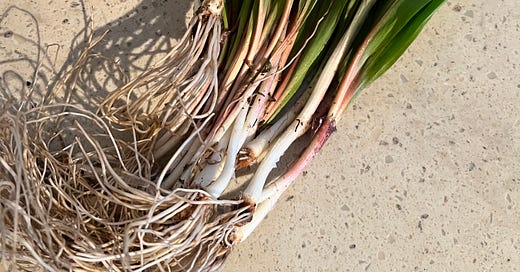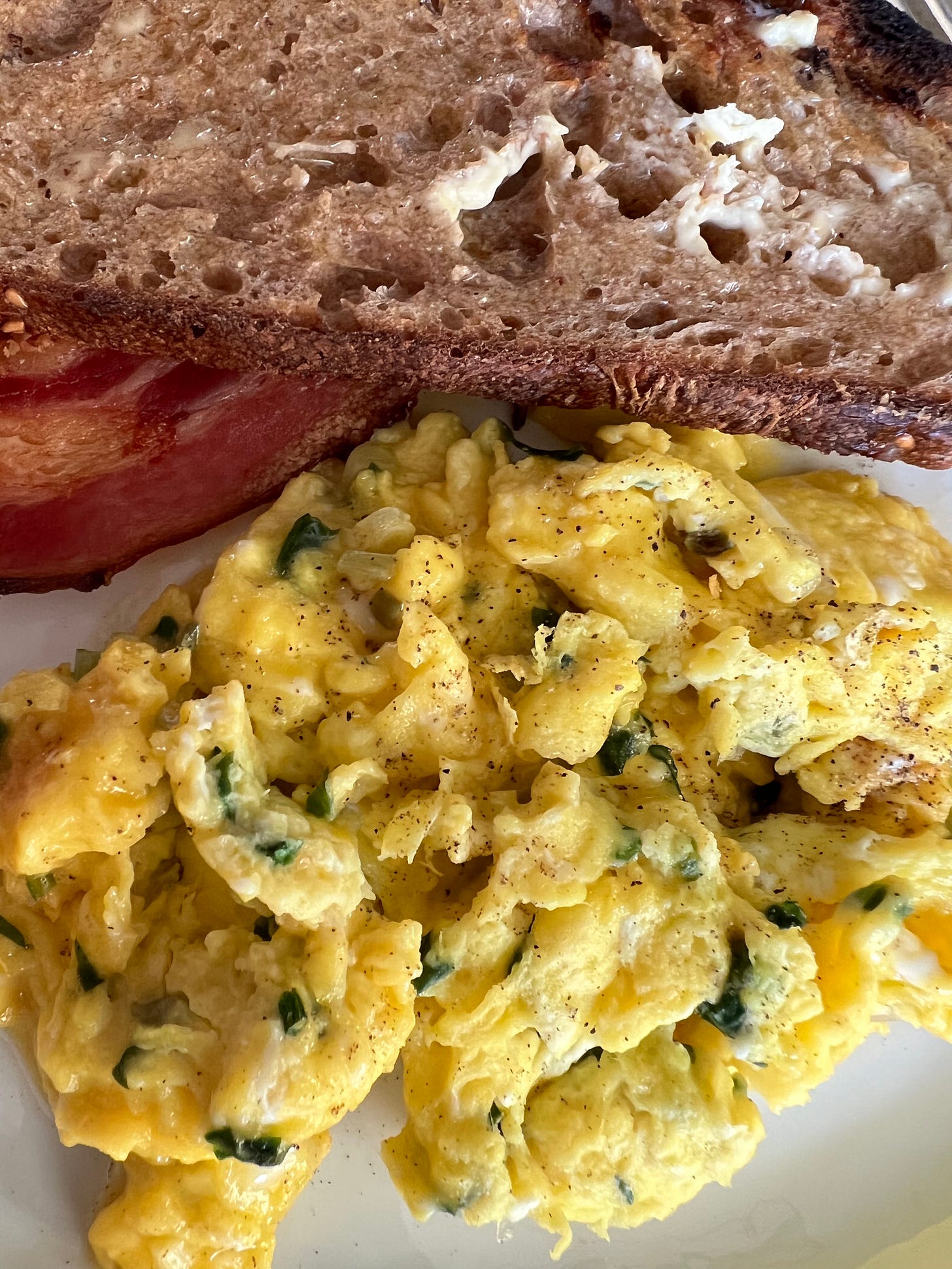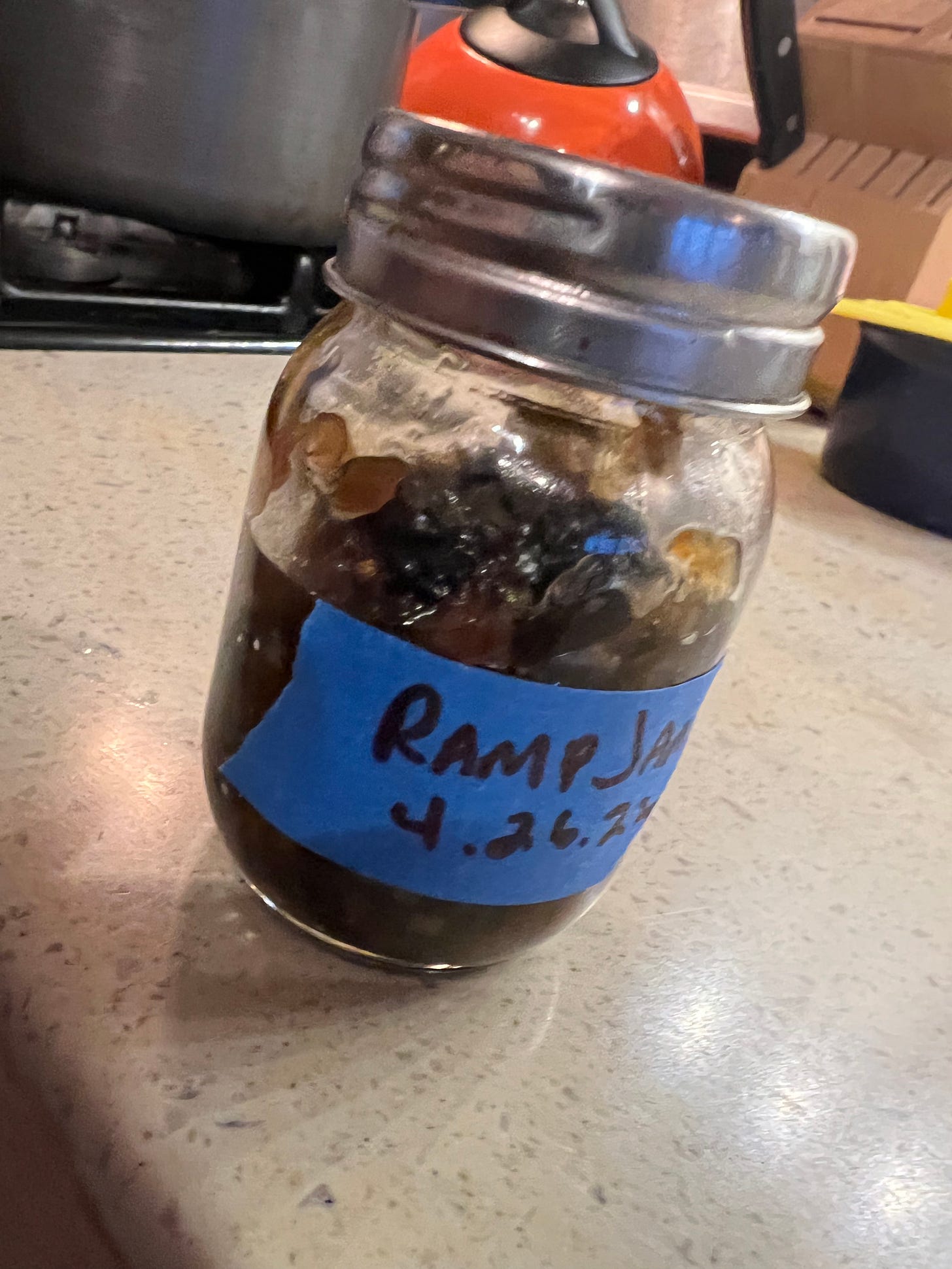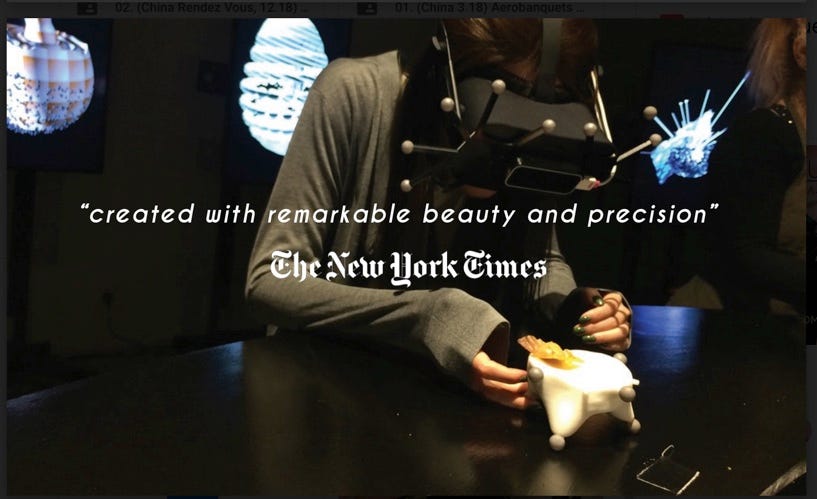On Ramps: Spring Has Arrived at the Market in the Form of Wild Alliums
A Favorite Condiment: Ramp Jam; ew "What’s Burning" Episodes with Zimmern, Crenn, and Chatenier; Plus, a Chance To Dine in the Metaverse
Issue #48. Recuperating from COVID-19 in isolation at the lakehouse—in “isolation” together with Nate, who also caught the plague—continues apace. Mostly good days. Monday was a bad day. I didn’t really get out of bed, and moreover, I didn’t eat—my mother would have joked there was no need to call an ambulance when any of her children lost their appetite, she knew to go straight to the undertaker. Anyway, today is a new day. This week, in addition to a seasonal recipe for something I just cooked, in this case ramp jam, I give you news on two other projects I’m working on, my What’s Burning podcast and Aerobanquets RMX, a virtual reality dining pop-up you can experience if you are anywhere near Brooklyn mid-May. Thank you for your continued support. —Mitchell
This is a funny season for local produce in the northeast. The days are warmer, longer, and sunnier than they have been for months. But the ground is still too cold or too muddy to be productive. The other day Nate and I took a walk on the path through the woods across from the lakehouse and there was an older couple standing in a dip off to the side of the trail. When we approached they explained they were looking at “spring ephemerals,” beautiful little white, purple and yellow flowers poking through the bed of wet, dead leaves. The Union Square Greenmarket on the first warm spring day is always amusing to me. It’s packed with people looking for signs of life. But all they find is the same wool, honey, kimchi, shriveled potatoes, and mealy apples that were there last week when the ground was still covered with snow. Local produce takes some time.
Life does appear in fits and starts, though. The first ramps have already arrived from the folks who forage far enough south for the forests to have thawed. There are spring onions and delicate greens, like claytonia and cress, alongside woodier ones, like broccoli raab and collards that have been kept over the winter to decrease their bitterness. Soon there will be fiddleheads, which most like the idea of more than the taste. Although I see social media posts of markets in warmer climes full of strawberries and asparagus, we are months away from either here. Rhubarb, which I always think should arrive earlier than it does, often isn’t available in any quantity until June.
Ramping Up
For all these reasons, wild alliums, the first sign of spring, create a frenzy when they arrive in the market. Although they have a cult following, they are not to everyone’s taste. I think this is because not everyone knows what to do with them. People treat them like spring onions, but they are nothing like spring onions. More fibrous, more pungent, I think they are best chopped fine and cooked to diminish any harsh edge. Nothing is more unpleasant than a tough, whole, grilled ramp as a garnish, which is almost inedible #imho. But chopped up and sautéed in olive oil to scramble with eggs for breakfast? Now we are talking spring.
A word about sustainable harvesting. You will likely see ramps for sale in bunches with their white bulbs and roots intact. In fact, this is the only way they appear in my local market. From the standpoint of sustainability, however, this is the worst way to cull them if you want to preserve the harvest from year to year. Instead, it’s best to cut the leaves off above the bulb, leaving the plant to continue propagating. I suspect this is a more time-consuming way to harvest them and it is certainly less attractive from a retail standpoint. I’m not sure how to change people’s perspective on this, but we all ought to try. In the meantime, I feel guilty when I buy my ramps with their roots.
As with any seasonal treat, key for ramps is to find ways to preserve them for later use so you can extend the pleasure of their unique flavor. This ramp jam is based on a recipe by my friend Hugh Acheson, a Canadian transplant who has become one of the best-known practitioners of southern cooking at his restaurants Five and Ten and Empire State South in Georgia. (Hugh is also a passionate political activist and a talented watercolorist.) I’ve added some spices to make it a cross between a jam and a relish. Sometimes I add some piquant pepper. I use whatever it is as a condiment on sandwiches, to top hors d’oeuvres of fresh ricotta on sourdough toast, to garnish deviled eggs. You will regret not having made enough to get you through to next spring.
Note, Hugh’s original recipe calls for pectin to assure a jammy consistency. I’ve made it both with and without the pectin, and it works fine in its looser form.
RECIPE: Ramp Jam
Makes about 1 1/2 cups
1 pound ramps (about 4 large bunches)
1 tablespoon olive oil
2 teaspoons coriander seed, cumin seed, brown or yellow mustard seed, or nigella seeds, or a combination
1 tablespoon sea salt
1 cup white wine vinegar
½ cup sugar
1 bay leaf, broken in half
1 teaspoon powdered pectin (optional)
Prepare the ramps. Slice off the roots if they have ‘em, remove the slimy outer epithelium, if present. Separate the green leaves from the white stalks and clean thoroughly of any mud, especially at the base of the leaves. Slice the whites thinly into rounds and the greens into 1/2 -inch pieces. Set aside.
In a medium saucepan, heat the oil over medium heat. Add the seeds and cook until they give off a toasted aroma and the mustard seeds, if using, begin to pop. Add the prepared ramps, salt, and bay leaf, and cook for 6 or 7 minutes or so until soft. Don’t allow them to color. Increase the heat to high and add the vinegar and sugar. Reduce the liquid by half. If using pectin, lower the heat back to medium and whisk in the pectin, stirring until it attains a jammy consistency, about 2 minutes. Transfer to a sterilized pint jar, cover, and cool. The jam can be refrigerated for up to a year, until ramps reappear in the market, but it won’t last that long.
If making a large quantity or you want to give as gifts, you can also process the ramp jam in sterilized half-pint jars a water bath for 7 minutes.
The Future of Food Education: Listen to “What’s Burning”

With an increasing awareness of the challenges presented by our ever-changing food system, the question of how best to educate the next generation of culinarians is top of mind. If you haven’t been listening to my new What’s Burning podcast, you’ve missed some important conversations about the interconnectedness of our food-production ecosystem (Dan Barber), the changing relationship of hospitality to labor (Nicolas Chatenier) and the importance of finding new voices to tell new stories (Jamila Robinson). And so much more. We are about to start taping the second season. Please listen, subscribe, and rate us on whatever platform you download your podcasts.
Dining in the Metaverse: Aerobanquets RMX Pop-Up at 99 Scott Studio
One of the last projects I did at the James Beard Foundation before lockdown was to install Aerobanquets RMX for a limited engagement at the Beard House in the fall of 2019. A unique project by artist Mattia Casalegno, Aeorbanquets RMX is the only virtual/augmented reality experience that allows you to eat real food while inside a digitally altered universe. Call it the first restaurant in the Metaverse. (Restaurants are always the first businesses in liminal neighborhoods, aren’t they?)
Inspired by Marinetti’s seminal Futurist Cookbook from 1932, the Aerobanquets journey takes you through various scenes and tastes that allow you to engage and interact with the abstract, fantastical story. A reviewer in the New York Times noted, “The scenes force awareness: I’ve never thought more about my teeth, the way saliva pools down inside my cheeks, the way spice burns the corners of my lips.” The Washington Post suggested Aerobanquets might be “the future of restaurants.” It’s super cool and now’s your chance to experience it for yourself during a very limited engagement at 99 Scott Studio in Brooklyn. Tickets are going fast.








